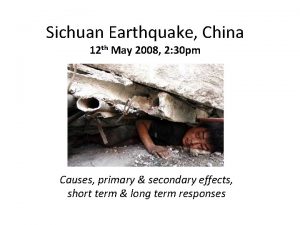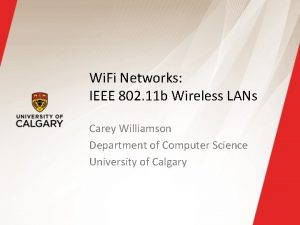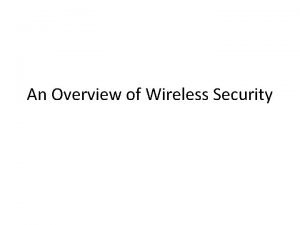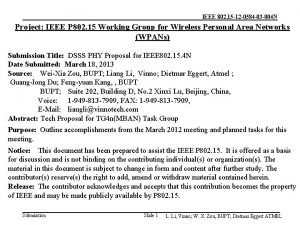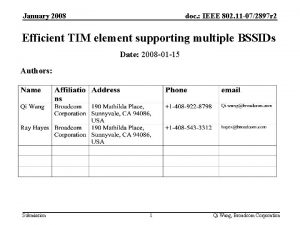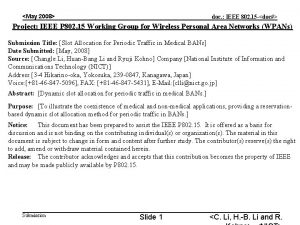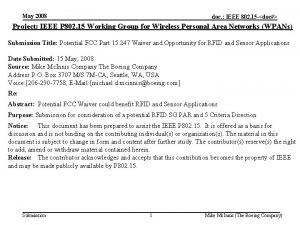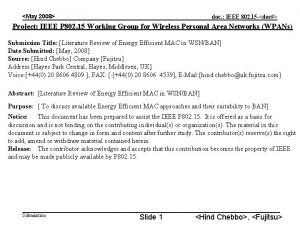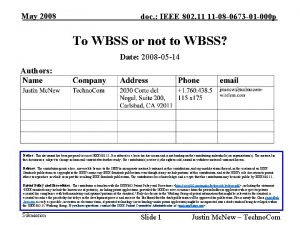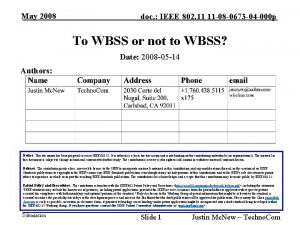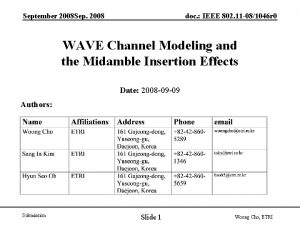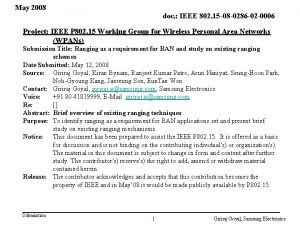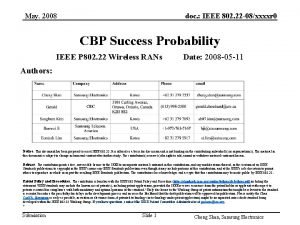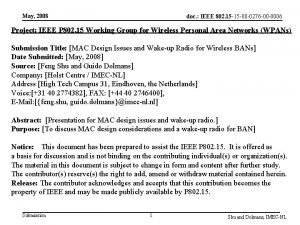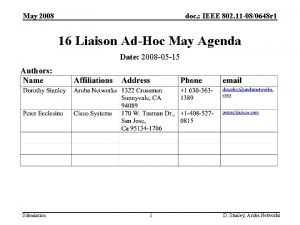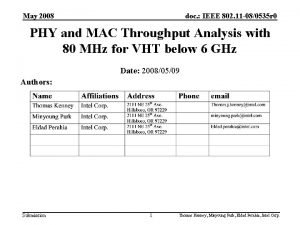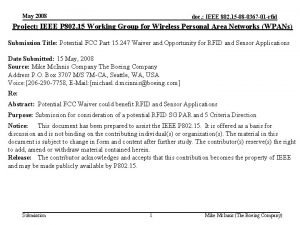May 2008 doc IEEE 802 11 072897 r


















- Slides: 18

May 2008 doc. : IEEE 802. 11 -07/2897 r 3 Efficient TIM element supporting multiple BSSIDs Date: 2008 -05 -13 Authors: Submission 1 Qi Wang, Broadcom Corporation

May 2008 doc. : IEEE 802. 11 -07/2897 r 3 Abstract This presentation proposes an improvement to the TIM element supporting multiple BSSIDs. Compared to the existing method defined in IEEE P 802. 11 v. D 2. 0, the proposed modification reduces the beacon frame size while incurring minimal additional complexity at an AP and no additional complexity at STAs. This presentation relates to LB 123 CID 171, 842, 914. Submission 2 Qi Wang, Broadcom Corporation

May 2008 doc. : IEEE 802. 11 -07/2897 r 3 Introduction • A modified TIM element supporting multiple BSSIDs is defined in the draft 11 v spec – A single AID space is shared by all stations associated with an AP which supports multiple BSSIDs • AID 0 to AID (2 n-1) are used for buffered broadcast/multicast frame indications • AID 2 n to AID 2007 are assigned to individual stations – A single beacon frame with a single TIM element is used to announce the buffered frames for all stations associated with one of the multiple BSSIDs supported by an AP Submission 3 Qi Wang, Broadcom Corporation

May 2008 doc. : IEEE 802. 11 -07/2897 r 3 Current TIM Element for Multiple BSSIDs (General Case) Contents of the Partial Virtual Bitmap field, and Bitmap. Offset = 0 Octet index 00 Bit index 0 N 2 (2 n-1) (N 2+1) 2007 1 0 Bits values depend on whether the corresponding BSSIDs have broadcast/multicast frames buffered at the AP or not Bits 0 to (2 n-1) indicate buffered broadcast/multicast frames at AP or not Bits values depend on whether the corresponding STAs have unicast frames buffered at the AP or not 0 Values of all bits are 0 s Bits 2 n to 2007 indicate buffered unicast frames at AP or not; Each bit corresponds to one STA Traffic Indication Virtual Bitmap Submission 4 Qi Wang, Broadcom Corporation

May 2008 doc. : IEEE 802. 11 -07/2897 r 3 Current TIM Element for Multiple BSSIDs (Special Case) Contents of the Partial Virtual Bitmap field, and Bitmap. Offset = 0 (Encoded as a single all 0 s octet) 0 0 Octet index Bit index 0 (2 n-1) 2007 0 0 Values of all bits are 0 s Bits 0 to (2 n-1) indicate buffered broadcast/multicast frames at AP or not Values of all bits are 0 s 1 Bits 2 n to 2007 indicate buffered unicast frames at AP or not; Each bit corresponds to one STA Traffic Indication Virtual Bitmap Submission 5 Qi Wang, Broadcom Corporation

May 2008 doc. : IEEE 802. 11 -07/2897 r 3 Review of TIM Element for Single BSSID in Base Spec – (General Case) Contents of the Partial Virtual Bitmap field, and Bitmap. Offset = N 1/2 Octet index 0 Bit index 0 (N 1 -1) N 1 N 2 (N 2+1) 2007 0 0 1 1 0 Values of all bits are 0 s Bits values depend on whether the corresponding STAs have unicast frames buffered at the AP or not 1 Bits 1 to 2007 indicate buffered unicast frames at AP or not; Each bit corresponds to one STA Traffic Indication Virtual Bitmap Submission 6 Qi Wang, Broadcom Corporation

May 2008 doc. : IEEE 802. 11 -07/2897 r 3 Inefficiency of TIM Element with Multiple BSSIDs in P 802. 11 v_D 2. 0 • Offset in TIM element with single BSSID provides efficiency – Offset = N 1/2 and PVB enables the reconstruction of Traffic Indication Virtual Bitmap • Mandating Offset=0 in call scenarios with multi-BSSID is inefficient • Allowing Offset ≠ 0 with multi-BSSID restores efficiency – AP has full knowledge of the content of traffic indication virtual bitmap to improve the PVB efficiency – Reduced TIM element size reduces beacon size and improves power save Submission 7 Qi Wang, Broadcom Corporation

May 2008 doc. : IEEE 802. 11 -07/2897 r 3 Proposed Modifications • Specify both Method A and Method B for PVB encoding and Bitmap. Offset field setting – Based upon its knowledge of STAs’ capabilities and the traffic bitmap content, an AP shall use either Method A or Method B • Use Method B for its efficiency wherever not incurring misinterpretation of received PVB by STAs; Use Method A, otherwise – Multi-BSSID & Non-zero Bitmap. Offset signals the use of Method B Method A Method B General Case (buffered uc and bc/mc frames) Octets numbered 0 to N 2 (currently defined in P 802. 11 v_D 2. 0) A concatenation of Octets numbered 0 to N 0 -1 and Octets numbered N 1 to N 2 Special Case 1 (no buffered frames) A single zero octet (currently defined in P 802. 11 v_D 2. 0) A single zero octet Special Case 2 (buffered bc/mc but no buffered uc frames) Octets numbered 0 to N 0 -1 Submission 8 Qi Wang, Broadcom Corporation

May 2008 doc. : IEEE 802. 11 -07/2897 r 3 Proposed Modification (General Case) Contents of the Partial Virtual Bitmap field, and Bitmap. Offset = (N 1 -N 0)/2 Octet index 00 Bit index 0 (N 0 -1) N 0 (N 1 -1) N 1 N 2 (N 2+1) (2 n-1) 2007 0 Bits values depend on whether the corresponding BSSIDs have broadcast/multicast frames buffered at the AP or not Bits 0 to (2 n-1) indicate buffered broadcast/multicast frames at AP or not 0 1 1 0 Values of all bits are 0 s Bits values depend on whether the corresponding STAs have unicast frames buffered at the AP or not 0 Values of all bits are 0 s 1 Bits 2 n to 2007 indicate buffered unicast frames at AP or not; Each bit corresponds to one STA Traffic Indication Virtual Bitmap Submission 9 Qi Wang, Broadcom Corporation

May 2008 doc. : IEEE 802. 11 -07/2897 r 3 Proposed TIM Modification (Special Case 1) Contents of the Partial Virtual Bitmap field, and Bitmap. Offset = 0 (Encoded as a single all 0 s octet) 0 0 Octet index Bit index 0 (2 n-1) 2007 0 0 Values of all bits are 0 s Bits 0 to (2 n-1) indicate buffered broadcast/multicast frames at AP or not Values of all bits are 0 s 1 Bits 2 n to 2007 indicate buffered unicast frames at AP or not; Each bit corresponds to one STA Traffic Indication Virtual Bitmap Submission 10 Qi Wang, Broadcom Corporation

May 2008 doc. : IEEE 802. 11 -07/2897 r 3 Proposed Modification (Special Case 2) Contents of the Partial Virtual Bitmap field, and Bitmap. Offset = 0 Octet index 00 Bit index 0 (N 0 -1) N 0 (2 n-1) 2007 0 0 Bits values depend on whether the corresponding BSSIDs have broadcast/multicast frames buffered at the AP or not Bits 0 to (2 n-1) indicate buffered broadcast/multicast frames at AP or not Values of all bits are 0 s Bits 2 n to 2007 indicate buffered unicast frames at AP or not; Each bit corresponds to one STA Traffic Indication Virtual Bitmap Submission 11 Qi Wang, Broadcom Corporation

May 2008 doc. : IEEE 802. 11 -07/2897 r 3 Comparison – General Case Existing Method in P 802. 11 v_D 2. 0 Proposed Method Contents of the Partial Virtual Bitmap field Octets numbered 0 to N 2 (methods neither specify nor use N 0 and N 1) A concatenation of octets numbered 0 to N 0 -1 and octets numbered N 1 to N 2 Values of Bitmap Offset in the Bitmap Control field 0 (N 1 -N 0)/2 Size of the Partial Virtual Bitmap field N 2+1 octets N 2+1 -(N 1 -N 0) octets Size of TIM element N 2+4 octets N 2+ 4 -(N 1 -N 0) octets Submission 12 Qi Wang, Broadcom Corporation

May 2008 doc. : IEEE 802. 11 -07/2897 r 3 Summary • An AP decides whether to use method A or method B for PVB encoding and Bitmap. Offset setting of the TIM element • Whenever used in appropriate situations, Method B reduces the size of the TIM element and improves performance in terms of: – Reduction of beacon size and medium occupancy time as well as BSS collision rate – Improvement of power save • The proposed changes incur minimal additional complexity at an AP but no additional complexity at non-AP STAs. Submission 13 Qi Wang, Broadcom Corporation

May 2008 doc. : IEEE 802. 11 -07/2897 r 3 Motion • Move to adopt the text proposal in document IEEE 802. 1107/2898 r 2 into the TGv draft Mover: Seconder: Result: Submission 14 Qi Wang, Broadcom Corporation

May 2008 doc. : IEEE 802. 11 -07/2897 r 3 References • IEEE P 802. 11 v. TM/D 2. 0, Draft standard for information technologytelecommunications and information exchange between systems – Local and metropolitan area networks – specific requirements, Part 11: Wireless LAN Medium Access controal (MAC) and Physical Layer (PHY) specifications, Amendment 9: Wireless Network Management Submission 15 Qi Wang, Broadcom Corporation

May 2008 doc. : IEEE 802. 11 -07/2897 r 3 Appendix Submission 16 Qi Wang, Broadcom Corporation

May 2008 doc. : IEEE 802. 11 -07/2897 r 3 Example Scenarios of Using Method B • Example scenarios where a more efficient PVB encoding method is possible without incurring misinterpretation by the legacy and 11 v STAs – Example: no legacy STAs in the BSS – Example: bits 0 to (2 n-1) of the Traffic Indication Virtual Bitmap are all 0 s – Example: The AP knows all legacy STAs cannot wrongly interpret the Partial Virtual Bitmap. • That is, when legacy STAs prepend 2 x. Bitmap_Offset octets all 0 bits before octet 0 of the Partial Virtual Bitmap generated using a new method (i. e. , Method B) to form a “Modified Partial Virtual Bitmap”, none of the legacy STAs’ AIDs corresponds to the last 2 n bits of this “Modified Partial Virtual Bitmap”. Submission 17 Qi Wang, Broadcom Corporation

May 2008 doc. : IEEE 802. 11 -07/2897 r 3 Interpretation at Stations (PVB ≠ a single all-zero octet) Bitmap. Offset = 0 Bitmap. Offset ≠ 0 Single BSSID Multiple BSSIDs No need to prepend the received PVB Prepend (2×Bitmap. Offs et) octets of the received PVB Infer N 0 from 2 n, and insert (2×Bitmap. Offset) octets between bit (N 0× 8 -1) and bit N 0× 8 of the received PVB Legacy STAs (no No need to understanding of prepend the multiple BSSIDs) received No need to prepend the received PVB Prepend (2×Bitmap. Offs et) octets of the received PVB Prepend (2×Bitmap. Offset) octets of the received PVB (Note: method B can only be used with legacy STAs in the BSS if such a prepending does not incur PVB misinterpretation by legacy STAs) 11 v STAs (understanding of multiple BSSIDs) PVB Note 1: if PVB = single zero octet, both new and legacy STAs interpret all bits in the Traffic Indication Virtual Bitmap as zeros. Note 2: the combination of multi-BSSID and Offset ≠ 0 signals the use of Method B Submission 18 Qi Wang, Broadcom Corporation
 Bridges from 802.x to 802.y
Bridges from 802.x to 802.y Bridges from 802.x to 802.y
Bridges from 802.x to 802.y Wlan standards
Wlan standards Arquitetura ieee 802
Arquitetura ieee 802 Ieee 802 que es
Ieee 802 que es Ieee 802 standard
Ieee 802 standard Bluetooth ieee 802
Bluetooth ieee 802 802 ieee
802 ieee Ieee 802
Ieee 802 Ieee 802 family
Ieee 802 family Ieee 802 3 compliance
Ieee 802 3 compliance 2008 2008
2008 2008 Ieee 829 example
Ieee 829 example Norma ieee 754
Norma ieee 754 12th may 2008
12th may 2008 Hci patterns may or may not include code for implementation
Hci patterns may or may not include code for implementation 802 11 b
802 11 b 802-11-wireless-security
802-11-wireless-security 802 15
802 15














